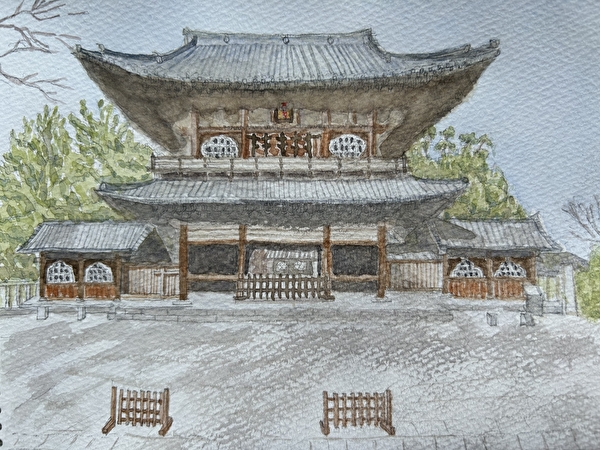「大樹寺」
Do you know about Japanese temples? Daijuji Temple is a temple associated with Ieyasu Tokugawa. At 4T-AMKY, Teachers and Students write about Japanese culture, food, history, many spots to visit, and other stuff. Enjoy reading and knowing about deeper Japanese culture!
Daijuji Temple
Origin
Daijuji Temple is a Jodo sect temple founded in 1475 by Chikatada Matsudaira, the fourth Matsudaira generation. It is well known as the family temple of the Matsudaira family and the Tokugawa shoguns. It is located in Okazaki City, Aichi Prefecture.
Teachings
When Ieyasu, the ninth Matsudaira lord, was 19 years old, he fled to Daijuji Temple when Yoshimoto Imagawa was defeated by Nobunaga Oda in the Battle of Okehazama (1560), fearing for his safety. When he despaired and decided to commit suicide in front of his ancestor’s grave, he was stopped by the priest. He was taught to “Onriedo Gongujodo” ‘厭離穢土欣求浄土’ (your role is to make the war-torn world a better place to live), and he decided not to commit seppuku (suicide). Since then, Ieyasu has adopted the motto “Onriedo Gongujodo” ‘厭離穢土欣求浄土’ as his motto for the rest of his life.
Many of you may be familiar with this episode as it was featured in last year’s historical drama series on NHK TV, in which the Daijuji Temple played a major historical role in saving Lord Ieyasu from a difficult situation. In the inner sanctuary of the main hall of Daijuji Temple, there was a splendid display of the Buddhist teaching, “Onriedo Gongujodo.” ‘厭離穢土欣求浄土’

Sanmon Gate
The top photo is a sketch of the Sanmon gate facing the main hall. This gate was built in 1641 by the third shogun, Iemitsu Tokugawa. It is a cultural asset designated by the prefecture. On the Sanmon gate, there is an imperial inscription by Emperor Go Nara, “Daijuji Temple.” ‘大樹寺’ It is an important cultural property. The word “Daiju” is said to mean “general” in Tang Chinese.
From the main hall, you can see Okazaki Castle in a straight line through the Sanmon and Somon gates. The 3 km straight line connecting Okazaki Castle and Daijuji Temple is called the “Vista Line.” It is said that this view was created when Lord Iemitsu renovated and built the Daijuji temple complex, with the idea of ” viewing the place where my grandfather (Ieyasu) was born. This view is protected by city ordinance.

Bell Tower
In 1641, Lord Iemitsu built the bell tower. The large bell on the tower was recast by the ninth shogun, Ieshige Tokugawa. Every year, people line up to ring the bell on New Year’s Day.

Two-storied Pagoda
There are no buildings from the time of the temple’s founding at Daijuji Temple. The oldest building of Daijuji Temple is a two-storied pagoda built in 1535 by Kiyoyasu Matsudaira, the grandfather of Lord Ieyasu. It is said to show the style of the late Muromachi era (1336-1573) and is a national important cultural property. I felt the warmth and beauty of the building’s rounded architecture.

Main hall
In 1855, a fire destroyed the main building, including the main hall, Kuri (priests’ quarters), and Shoin (drawing room). It was rebuilt in 1857 by the thirteenth shogun Iesada Tokugawa, but due to frugality at the end of the Edo era, the scale of the building was reduced by 20-30%. It is said that the roof of the main hall seems somewhat low as a result of frugality.

Ancestors Matsudaira Eight Generations and Lord Ieyasu’s Cemetery
In 1615, Ieyasu constructed the mausoleum for his ancestors, the Matsudaira Eight Generations, within the temple grounds. In 1617, the first anniversary of Ieyasu’s death was held, and it is said that the present form of the Matsudaira family tomb was completed. In 1969, a tomb and monument were erected by the Daijuji Preservation Society to enshrine the relics of Lord Ieyasu.
Tablets of Successive Shoguns
The Daijuji Temple enshrines the tablets from Ieyasu Tokugawa, the first shogun, to Iemochi Tokugawa, the fourteenth shogun. The height of the tablets is said to be in accordance with the height of the deceased at the time of death.
The tablet of Yoshinobu Tokugawa, the last shogun of the Edo Shogunate, is not enshrined in the temple. It is said that this is because Yoshinobu was still alive after he retired from the Shogunate, and in consideration of Emperor Meiji, he willed to be buried in a Shinto ceremony instead of a Buddhist ceremony.
Ieyasu, who died at Sunpu Castle on April 17, 1616, left a will: “The body shall be buried at Kunouzan on Suruga, the funeral ceremony shall be held at Zojoji Temple in Edo, the tablets shall be placed at Daijuji Temple on Mikawa, and after the first anniversary of his death, a small hall shall be built on Nikko Mountain in Shimotsuke to serve as a shrine for the eight provinces of Kanto.” I see why the tablets of successive Tokugawa shoguns are enshrined at Daijuji Temple.
「大樹寺」
起源
大樹寺は、松平第四代親忠(ちかただ)が、1475年(文明7年)に創建した浄土宗のお寺です。松平家と徳川将軍家の菩提寺としてよく知られています。愛知県岡崎市にあります。
教え
松平第九代の家康公は19歳の時、桶狭間の合戦(1560年)で今川義元が織田信長に討たれた際、身の危険を感じて大樹寺へ逃げ込みます。絶望して先祖の墓前で自害することを決意した時、住職から引き止められました。そして「厭離穢土欣求浄土(おんりえど、ごんぐじょうど)」の教え(戦国乱世を住みよい浄土にするのがお前の役目)を受け切腹を思いとどまりました。以来、家康公は旗印に「厭離穢土欣求浄土」を掲げ、生涯の座右の銘としたそうです。
大樹寺が、家康公を苦境から救い、歴史的にも大きな役割を果たしたお寺である、ということは昨年の大河ドラマでも紹介されたので、このエピソードをご存じの方も多いのではないでしょうか。大樹寺本堂の内陣には「厭離穢土欣求浄土」が立派に掲げられていました。
山門
トップの写真は、本堂に向かって山門をスケッチしたものです。この山門は1641年(寛永18年)、三代将軍徳川家光公により建立されました。県指定文化財です。山門には後奈良天皇の勅額「大樹寺」がかかげられています。重要文化財です。「大樹」とは唐名で「将軍」を意味する言葉だそうです。
本堂からは、山門、総門を通して一直線上に岡崎城を望む事ができます。岡崎城と大樹寺を結ぶ約3kmの直線は「ビスタライン」と呼ばれています。「祖父(家康)が生まれた地を望めるように」という考えから、家光公が大樹寺の伽藍を再改修し造営したことでこの景観となったそうです。市の条例でもこの景観は保護されています。
鐘楼
同1641年(寛永18年)に、家光公が鐘楼を建立しました。楼上の大鐘は九代将軍家重公改鋳によるものです。毎年、除夜の鐘で人の列ができるそうです。
多宝塔
大樹寺には創建当時の建物はありません。1535年(天文4年)に家康公の祖父松平清康が建立した多宝塔が、大樹寺最古の建物です。室町末期の様式を示しているそうで、 国重要文化財です。丸みを帯びた建物の温かさと美しさを感じました。
本堂
1855年(安政2年)、出火により本堂、庫裏、書院など主要建物が全焼しました。1857年(安政4年)に徳川十三代家定公により再建されましたが、幕末の倹約の折、2~3割減の規模での再建となったそうです。本堂の屋根がなんとなく低く感じられるのは倹約の結果であると言われています。
先祖松平八代と家康公墓地
1615年(元和元年)に、家康公は先祖松平八代廟所を寺内に建立しました。1617年には家康公の一周忌が営まれ、現在の松平家の墓の姿が整ったとされています。1969年(昭和44年)に大樹寺保存会により家康公の遺品を納めて墓と碑が建立されました。
歴代将軍位牌
大樹寺には、初代将軍・徳川家康にはじまり十四代将軍・徳川家茂(とくがわいえもち)までの位牌が安置されています。位牌の高さは、臨終時の身長に合わせていると伝えられています。
江戸幕府最後の将軍・徳川慶喜(とくがわよしのぶ)の位牌は安置されていません。慶喜が将軍職を退いたあとも存命であったことと、明治天皇に配慮し仏式ではなく神式で葬られることを遺言したからだと伝えられています。
1616年(元和2年)4月17日、駿府城で死去した家康は、「遺体は駿河久能山に葬ること、葬礼は江戸増上寺で行うこと、位牌は三河大樹寺に立てること、一周忌が過ぎたら下野日光山に小堂を建てて勧請せよ、これにて関八州の鎮守とせよ」と遺言していたのだそうです。なるほど、大樹寺に徳川歴代将軍の位牌が安置されている理由がわかりました。
Ikuyo.K.






